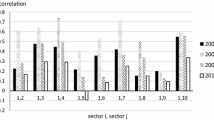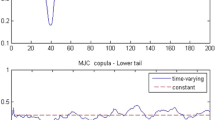Abstract
Usually, large changes in equity price indices merit specific attention. If they are negative, they are particularly important as they have a potentially more severe impact on balance sheets than changes of normal size.
The stock market is filled with individuals who know the price of everything, but the value of nothing.
Phillip Fihser
Raj S. Dhankar and Madhumita Chakraborty, Dependences in Stock Markets of South Asia : India, Sri Lanka and Pakistan, Prajnan, Vol. XXXIV, No. 3, 2005–06.
Access this chapter
Tax calculation will be finalised at checkout
Purchases are for personal use only
Similar content being viewed by others
Notes
- 1.
For example, see Fama (1970) for a comprehensive review.
- 2.
The Milanka Price Index (MPI) was introduced in January 1999 replacing the Sensitive Price Index (SPI). Hence, in this study, we consider the Sensitive Price Index from January 1991 to December 1998 and Milanka Price Index from January 1999 to December, 2001. However, in the text, we shall refer to the whole series as Milanka Price Index.
- 3.
- 4.
One variation of serial dependence is called mean reversion. With mean reversion, returns revert to an average value or asset prices revert to an equilibrium value. If an asset is priced above its equilibrium value, its price will not change randomly, it will be more inclined to decrease than to increase. Conversely, if an asset is priced below its equilibrium value, it will be more likely to increase than to depreciate further.
- 5.
Another variation of serial dependence is known as trending. In a trending pattern, a positive return is more likely to be followed by another positive return than a reversal, and a negative return is likely to be succeeded by another negative return than a positive return.
- 6.
The detailed results are not reported here, but are available from the authors on request.
References
Al-Loughani, N., & Chappell, D. (1997). On the validity of the weak-form efficient markets hypothesis applied to the London stock exchange. Applied Financial Economics, 7(1997), 173–176.
Ammermann, A (1999). Nonlinearity and Overseas Capital Markets: Evidence from the Taiwan Stock Exchange. Doctoral Dissertation Submitted to the Faculty of the Virginia Polytechnic Institute and State University, 1999.
Ayadi, O. F., & Pyun, C. S. (1994). An application of variance ratio test to the korean securities market. Journal of Banking and Finance, 18, 643–658.
Bachelier, L. (1900). Theorie de la Speculation, Paris, Cauthier-Villurs, Translation by James Boness, A., Reprinted in Cootner (1964), pp 17–78.
Barua, S. K. (1981). The short-run price behavior of securities—Some evidence of Indian capital market. Vikalpa, 16(2), 1981.
Brock, W., Hsieh, D. A., & LeBaron, B. (1991). Nonlinear dynamics, chaos, and instability: Statistical theory and economic evidence (p. 1991). Cam bridge, MA: The MIT Press.
Brock, W., Lakonishok, J., & LeBaron, B. (1992). Simple technical trading rules and the stochastic properties of stock returns. The Journal of Finance, XLVII(5), 1731–64.
Brock, W., Dechert, W., Scheinkman, J., & LeBaron, B. (1996). A test for independence based on the correlation dimension. Econometric Reviews, 15 (3), 197–235.
Chaudhury, S. K. (1991). Short-run share price behavior: New evidence on weak form of market efficiency. Vikalpa, 16(4), 17–21.
Cochrane, J. (1988). How big is the random walk in the GNP. Journal of Political Economy, 96(1988), 893–920.
De Bondt, W. F. M., & Thaler, R. (1985). Does the stock market overreact? The Journal of Finance, 40(3), 793–805.
Dhankar, R. S. (1991). Empirical tests of the efficiency of Indian stock market. Journal of Financial Management and Analysis, 4(2).
Elyasiani, E., Perera, P., & Puri, T. (1996). Market efficiency and calendar anomalies in emerging capital markets: Evidence from the colombo stock exchange. Journal of International Financial Markets Institutions and Money, 6(1996), 59–77.
Fama, E. F. (1965). The behaviour of stock market prices. Journal of Business, 38(1), 34–105.
Fama, E. F. (1970). Efficient capital markets: A review of theory and empirical work. Journal of Finance, 25, 387–417.
Fama, E. F., & French, K. R. (1988). Permanent and temporary components of stock prices. Journal of Political Economy, 96(1988), 246–273.
Gupta, 0. P. (1985). Behavior of share prices in india—A test of market efficiency. New Delhi: National Publishing House.
Harvey, C. R. (1994). Conditional asset allocation in emerging markets. Working Paper. Vol. 4623, Cambridge: MA.
Hsieh, D. A. (1991). Chaos and nonlinear dynamics: Application to financial markets. The Journal of Finance, XLVl(5), 1839–18377.
Hsieh, D. A. (1993). Implications of non-linear dynamics for financial risk management. Journal of Financial and Quantitative Analysis, 28(1993), 41–64.
Huizinga, John. (1987). An empirical investigation of the long-run behavior of real exchange rates. Carnegie-Rochester Conference Series on Public Policy, 27(1987), 149–214.
Husain, F. (1997). The random walk model in the Pakistani equity market: An examination. The Pakistan Development Review, 36(3), 221–240.
Jun, K., & Uppal, J. (1994). Portfolio flows to Pakistan: Trends and policies. In paper presented at the Private Sector Development Conference, Lahore University of Management Sciences, Lahore, 1994.
Khilji, N. (1993). The behavior of stock returns in an emerging market: A case study of Pakistan. The Pakistan Development Review, 32(4), 593–604.
Lintner, John. (1965). Security prices, risk, and maximum gains from diversification. Journal of Finance, 20(1965), 587–615.
Liu, C. Y., & He, J. (1991). A variance ratio test of random walks in foreign exchange rates. Journal of Finance, 46(1991), 773–785.
Lo, A. W., & MacKinlay, A. C. (1988). Stock market prices do not follow random walks: Evidence from a simple specification test. The Review of Financial Studies, 1, 41–66.
Lo, A. W., & MacKinlay, A. C. (1989). The size and power of the variance ratio test in finite samples: A monte carlo investigation. Journal of Econometrics, 40(1989), 203–238.
Madhusoodanan, T. P. (1998). Persistence in the Indian stock market returns: An application of variance ratio test. Vikalpa, 23(4), 61–73.
Mandelbort, B. (1963). The variation of certain speculative prices. Journal of Business, 36, 394–419. Reprinted in Cootner (1964). pp. 307–33 2.
Osborne, M. F. M. (1959). Brownian motion of stock market. Operations Research, 7(2), 145–173. Reprinted in Cootner (1964). pp. 100–128.
Osborne, M. F. M. (1962). Periodic structure in the brownian motion of stock prices. Operations Research, 10(1962), 345–379.
Poshakwale, S. (2002). The random walk hypothesis in the emerging indian stock market. Journal of Business Finance & Accounting, 29(9) & (10), 1275–1299.
Poshakwale, S., & Wood, D. (1998). Conditional variance and non-linearity in the polish emerging market. In J. Choi & J. Doukas (Eds.), Emerging capital markets: Financial and investment issues (pp. 205–224). Westport: Quorum Books.
Poterba, J. M., & Summers, L. H. (1988). Mean reversion in stock prices: Evidence and implications. Journal of Financial Economics, 22(1988), 27–59.
Ray, D. (1976). Analysis of security prices in India. Sankhya, Series C, Vol. 381.
Samuelson, P. A. (1965). Proof that properly anticipated prices fluctuate randomly. Industrial Management Review, 6(2), 41–49.
Sewell, S. P., Stansell, S. R., Lee, I., & Pan, M. S. (1993). Nonlinearities in emerging foreign capital markets. Journal of Business Finance and Accounting, 20(2), 237–248.
Sharma, J. L. & Kennedy, E. (1977, September). A comparative analysis of stock price behaviour on the Bombay, London and New York stock exchanges. Journal of Financial and Quantitative Analysis.
Sharpe, W. F. (1964). Capital asset prices: A theory of market equilibrium and conditions of risk. Journal of Finance, 19(1964), 425–443.
Willey, T. (1992). Testing for non-linear dependence in daily stock indices. Journal of Economics and Business, 44(1), 63–76.
Author information
Authors and Affiliations
Corresponding author
Rights and permissions
Copyright information
© 2019 Springer Nature India Private Limited
About this chapter
Cite this chapter
Dhankar, R.S. (2019). Dependences in Stock Markets of South Asia. In: Capital Markets and Investment Decision Making. Springer, New Delhi. https://doi.org/10.1007/978-81-322-3748-8_10
Download citation
DOI: https://doi.org/10.1007/978-81-322-3748-8_10
Published:
Publisher Name: Springer, New Delhi
Print ISBN: 978-81-322-3746-4
Online ISBN: 978-81-322-3748-8
eBook Packages: Economics and FinanceEconomics and Finance (R0)




